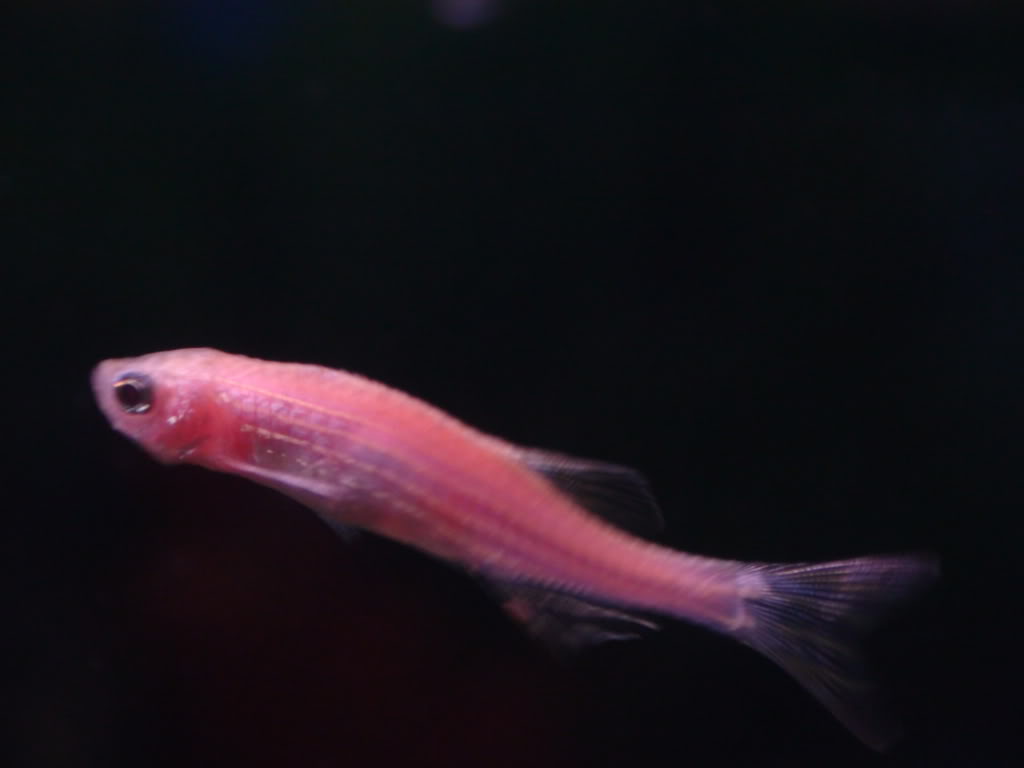nereksnad
Aquarium Advice Freak
- Joined
- Jan 27, 2011
- Messages
- 343
name: snakealike (lille tyndskid)

information: a little over a month ago, this specimen suddenly became very skinny, and as it swims it sometimes look as if it's a snake. however, it is healthy.
also note: this was originally written to a not-so aquarium oriented forum, which is why it is written in the way that it is.
description: [red] Brachydanio rerio, also known as red zebra fish, red zebra danio, and GlOinDdARK SPACIAL (GloFish™ fluorescent zebra fish), it is not intended for people to eat or see this fish if they laughed at the last mentioned name.
note: the specific details about this specimen are exactly like the regular brachydanio rerio (zebra danio). the red zebrafish accepts various temperatures between 22-28 degrees(C°), they should not be thrown in any rivers or water containment areas that contain less than 100 litres as they need vast space to swim in. they are also considered good for people who are not yet familiar with how to keep a fish alive, as they are not influenced much by the water quality, however, this does not mean you should avoid caring for them, they are also lifeforms!
the red zebrafish cares for having 3 or more pals in the water, and it is strictly not recommended to have a total of less than 4. they are also kind fish, and will not be rude to your other lifeforms.
they appreciate alot of plants, and decent flow in the water.
most of the time these fish will be in the top- and mid-level of the water, and they eat just about everything. though, used rubberbands are not recommended.
size is about 5-6 CM, and lifespan is 2-3 years. they are very fast swimmers.
native to east India, alot of zebrafish were put through scientific genetic modification, in order to make them glow in the dark. after it was successful, they were used to see just how much pollution there is in lake, they are still used today. making them "fluorescent" was made possible by injecting "fluorescent" genes into not-yet "fluorescent" eggs so that the offspring would be "fluorescent".
later on, the sudden realization that people would buy these modified fish arose and thus they were thrown in stores, but not all of them as some stores ban them, and in some places the amount of customers that are against the fish and boycotting the stores that sell them, is so high that the stores give in to the crowd's desire.
source(s): [1], [2], [3].
further reading: [4].
note: all given information may be changed without warning prior to feedback and/or noticed mistakes/mistypes and the incorporation of additional information or otherwise the removal of information.

information: a little over a month ago, this specimen suddenly became very skinny, and as it swims it sometimes look as if it's a snake. however, it is healthy.
also note: this was originally written to a not-so aquarium oriented forum, which is why it is written in the way that it is.
description: [red] Brachydanio rerio, also known as red zebra fish, red zebra danio, and GlOinDdARK SPACIAL (GloFish™ fluorescent zebra fish), it is not intended for people to eat or see this fish if they laughed at the last mentioned name.
note: the specific details about this specimen are exactly like the regular brachydanio rerio (zebra danio). the red zebrafish accepts various temperatures between 22-28 degrees(C°), they should not be thrown in any rivers or water containment areas that contain less than 100 litres as they need vast space to swim in. they are also considered good for people who are not yet familiar with how to keep a fish alive, as they are not influenced much by the water quality, however, this does not mean you should avoid caring for them, they are also lifeforms!
the red zebrafish cares for having 3 or more pals in the water, and it is strictly not recommended to have a total of less than 4. they are also kind fish, and will not be rude to your other lifeforms.
they appreciate alot of plants, and decent flow in the water.
most of the time these fish will be in the top- and mid-level of the water, and they eat just about everything. though, used rubberbands are not recommended.
size is about 5-6 CM, and lifespan is 2-3 years. they are very fast swimmers.
native to east India, alot of zebrafish were put through scientific genetic modification, in order to make them glow in the dark. after it was successful, they were used to see just how much pollution there is in lake, they are still used today. making them "fluorescent" was made possible by injecting "fluorescent" genes into not-yet "fluorescent" eggs so that the offspring would be "fluorescent".
later on, the sudden realization that people would buy these modified fish arose and thus they were thrown in stores, but not all of them as some stores ban them, and in some places the amount of customers that are against the fish and boycotting the stores that sell them, is so high that the stores give in to the crowd's desire.
source(s): [1], [2], [3].
further reading: [4].
note: all given information may be changed without warning prior to feedback and/or noticed mistakes/mistypes and the incorporation of additional information or otherwise the removal of information.
